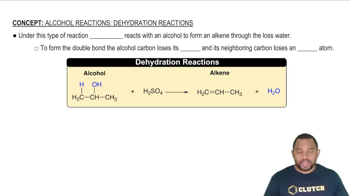Here are the essential concepts you must grasp in order to answer the question correctly.
Annihilation Reaction
Annihilation occurs when a particle and its antiparticle collide, resulting in their conversion into energy. In this case, when a positron (the antiparticle of the electron) meets an electron, they annihilate each other, producing energy in the form of photons. This process exemplifies the principle of mass-energy equivalence, as described by Einstein's equation E=mc².
Recommended video:
Alcohol Reactions: Dehydration Reactions
Photon Energy and Wavelength Relationship
The energy of a photon is inversely related to its wavelength, described by the equation E = hc/λ, where E is energy, h is Planck's constant, c is the speed of light, and λ is the wavelength. This relationship indicates that higher energy photons have shorter wavelengths. Understanding this concept is crucial for calculating the wavelength of photons produced in the annihilation process.
Recommended video:
Frequency-Wavelength Relationship
Conservation of Energy
In any physical process, the total energy before and after must remain constant, a principle known as the conservation of energy. In the case of electron-positron annihilation, the total rest mass energy of the electron and positron is converted into the energy of the two photons. This principle allows us to determine the energy of the photons produced, which can then be used to find their wavelength.
Recommended video:
Law of Conservation of Mass

 Verified step by step guidance
Verified step by step guidance

